�
Table of Content
TABLE OF CONTENT ........................................................................................................................................ 2
FOREWORD......................................................................................................................................................... 6
FOREWORD......................................................................................................................................................... 7
PREFACE.............................................................................................................................................................. 8
WHO SHOULD READ THIS BOOK ......................................................................................................................... 8
WHAT YOU WILL LEARN ..................................................................................................................................... 9
WHAT THIS BOOK DOES NOT COVER .................................................................................................................. 9
HOW THIS BOOK IS ORGANIZED........................................................................................................................ 10
ACKNOWLEDGEMENTS .......................................................................................................................................11
ABOUT THE COVER PICTURE ..............................................................................................................................11
INTRODUCTION............................................................................................................................................... 12
WHAT IS MESSAGING?....................................................................................................................................... 13
WHAT IS A MESSAGING SYSTEM? ...................................................................................................................... 14
WHY USE MESSAGING?..................................................................................................................................... 15
CHALLENGES OF ASYNCHRONOUS MESSAGING................................................................................................. 18
THINKING ASYNCHRONOUSLY........................................................................................................................... 19
DISTRIBUTED APPLICATIONS VS. INTEGRATION ................................................................................................. 19
COMMERCIAL MESSAGING SYSTEMS................................................................................................................. 20
PATTERN FORM.................................................................................................................................................. 22
DIAGRAM NOTATION ......................................................................................................................................... 24
EXAMPLES AND INTERLUDES............................................................................................................................. 25
ORGANIZATION OF THIS BOOK........................................................................................................................... 26
GETTING STARTED............................................................................................................................................. 27
SUPPORTING WEB SITE...................................................................................................................................... 29
SUMMARY.......................................................................................................................................................... 29
1.SOLVING INTEGRATION PROBLEMS USING PATTERNS............................................................... 31
THE NEED FOR INTEGRATION............................................................................................................................. 31
INTEGRATION CHALLENGES............................................................................................................................... 32
HOW INTEGRATION PATTERNS CAN HELP.......................................................................................................... 33
THE WIDE WORLD OF INTEGRATION.................................................................................................................. 34
LOOSE COUPLING .............................................................................................................................................. 37
1 MINUTE EAI................................................................................................................................................... 39
A LOOSELY COUPLED INTEGRATION SOLUTION................................................................................................. 42
WIDGET-GADGET CORP -- AN EXAMPLE ........................................................................................................... 44
SUMMARY.......................................................................................................................................................... 61
2.INTEGRATION STYLES............................................................................................................................ 63
INTRODUCTION.................................................................................................................................................. 63
APPLICATION INTEGRATION CRITERIA............................................................................................................... 63
APPLICATION INTEGRATION OPTIONS ................................................................................................................ 64
FILE TRANSFER.................................................................................................................................................. 65
SHARED DATABASE ........................................................................................................................................... 68
REMOTE PROCEDURE INVOCATION.................................................................................................................... 70
MESSAGING....................................................................................................................................................... 72
3.MESSAGING SYSTEMS............................................................................................................................. 75
INTRODUCTION.................................................................................................................................................. 75
MESSAGE CHANNEL .......................................................................................................................................... 76
MESSAGE........................................................................................................................................................... 81
PIPES AND FILTERS ............................................................................................................................................ 84
MESSAGE ROUTER............................................................................................................................................. 91
MESSAGE TRANSLATOR..................................................................................................................................... 96
MESSAGE ENDPOINT........................................................................................................................................ 105
4.MESSAGING CHANNELS ....................................................................................................................... 108
INTRODUCTION................................................................................................................................................ 108
POINT-TO-POINT CHANNEL...............................................................................................................................111
PUBLISH-SUBSCRIBE CHANNEL........................................................................................................................113
DATATYPE CHANNEL ........................................................................................................................................116
INVALID MESSAGE CHANNEL ...........................................................................................................................119
DEAD LETTER CHANNEL ................................................................................................................................. 122
GUARANTEED DELIVERY................................................................................................................................. 124
CHANNEL ADAPTER......................................................................................................................................... 128
MESSAGING BRIDGE........................................................................................................................................ 132
MESSAGE BUS ................................................................................................................................................. 135
5.MESSAGE CONSTRUCTION.................................................................................................................. 140
INTRODUCTION................................................................................................................................................ 140
COMMAND MESSAGE ...................................................................................................................................... 141
DOCUMENT MESSAGE ..................................................................................................................................... 143
EVENT MESSAGE ............................................................................................................................................. 145
REQUEST-REPLY .............................................................................................................................................. 147
RETURN ADDRESS ........................................................................................................................................... 151
CORRELATION IDENTIFIER ............................................................................................................................... 154
MESSAGE SEQUENCE....................................................................................................................................... 159
MESSAGE EXPIRATION..................................................................................................................................... 164
FORMAT INDICATOR......................................................................................................................................... 167
6.INTERLUDE:SIMPLE MESSAGING .................................................................................................. 169
INTRODUCTION................................................................................................................................................ 169
JMS REQUEST/REPLY EXAMPLE...................................................................................................................... 171
.NET REQUEST/REPLY EXAMPLE .................................................................................................................... 182
�
JMS PUBLISH/SUBSCRIBE EXAMPLE ............................................................................................................... 191
7.MESSAGE ROUTING............................................................................................................................... 208
INTRODUCTION................................................................................................................................................ 208
CONTENT-BASED ROUTER................................................................................................................................211
MESSAGE FILTER............................................................................................................................................. 217
DYNAMIC ROUTER .......................................................................................................................................... 221
RECIPIENT LIST................................................................................................................................................ 226
SPLITTER ......................................................................................................................................................... 234
AGGREGATOR .................................................................................................................................................. 242
RESEQUENCER................................................................................................................................................. 255
COMPOSED MESSAGE PROCESSOR................................................................................................................... 265
SCATTER-GATHER............................................................................................................................................ 267
ROUTING SLIP.................................................................................................................................................. 270
PROCESS MANAGER ........................................................................................................................................ 278
MESSAGE BROKER .......................................................................................................................................... 286
8.MESSAGE TRANSFORMATION............................................................................................................ 291
INTRODUCTION................................................................................................................................................ 291
ENVELOPE WRAPPER....................................................................................................................................... 292
CONTENT ENRICHER........................................................................................................................................ 297
CONTENT FILTER ............................................................................................................................................. 302
CLAIM CHECK ................................................................................................................................................. 305
NORMALIZER................................................................................................................................................... 310
CANONICAL DATA MODEL............................................................................................................................... 312
9.INTERLUDE:COMPOSED MESSAGING........................................................................................... 317
INTRODUCTION................................................................................................................................................ 317
SYNCHRONOUS IMPLEMENTATION USING WEB SERVICES ................................................................................ 324
ASYNCHRONOUS IMPLEMENTATION WITH MSMQ........................................................................................... 353
ASYNCHRONOUS IMPLEMENTATION WITH TIBCO ACTIVEENTERPRISE........................................................... 397
10.MESSAGING ENDPOINTS .................................................................................................................... 415
INTRODUCTION................................................................................................................................................ 415
MESSAGING GATEWAY..................................................................................................................................... 418
MESSAGING MAPPER....................................................................................................................................... 426
TRANSACTIONAL CLIENT................................................................................................................................. 431
POLLING CONSUMER ....................................................................................................................................... 439
EVENT-DRIVEN CONSUMER............................................................................................................................. 442
COMPETING CONSUMERS ................................................................................................................................ 446
MESSAGE DISPATCHER .................................................................................................................................... 451
SELECTIVE CONSUMER.................................................................................................................................... 457
DURABLE SUBSCRIBER.................................................................................................................................... 464
IDEMPOTENT RECEIVER................................................................................................................................... 469
SERVICE ACTIVATOR ........................................................................................................................................ 472
�
11.SYSTEM MANAGEMENT ..................................................................................................................... 476
INTRODUCTION................................................................................................................................................ 476
CONTROL BUS ................................................................................................................................................. 477
DETOUR........................................................................................................................................................... 481
WIRE TAP ........................................................................................................................................................ 482
MESSAGE HISTORY.......................................................................................................................................... 484
MESSAGE STORE ............................................................................................................................................. 487
SMART PROXY ................................................................................................................................................. 489
TEST MESSAGE................................................................................................................................................ 498
CHANNEL PURGER........................................................................................................................................... 500
12.INTERLUDE:SYSTEM MANAGEMENT EXAMPLE..................................................................... 504
LOAN BROKER SYSTEM MANAGEMENT........................................................................................................... 504
13.INTEGRATION PATTERNS IN PRACTICE ....................................................................................... 528
CASE STUDY: BOND TRADING SYSTEM ........................................................................................................... 528
ARCHITECTURE WITH PATTERNS...................................................................................................................... 529
14.CONCLUDING REMARKS.................................................................................................................... 548
EMERGING STANDARDS AND FUTURES IN ENTERPRISE INTEGRATION.............................................................. 548
BIBLIOGRAPHY ............................................................................................................................................. 569
�
Foreword
by John Crupi
What do you do when a new technology arrives? You learn the technology. This is exactly what I
did. I studied J2EE (being from Sun Microsystems, it seemed to be the logical choice). Specifically,
I focused on the EJB technology by reading the specifications (since there were no books yet).
Learning the technology, however, is just the first step—the real goal is to learn how to effectively
apply the technology. The nice thing about platform technologies is that they constrain you to
performing certain tasks. But, as far as the technology is concerned, you can do whatever you
want and quite often get into trouble if you don’t do things appropriately.
One thing I’ve seen in the past 15 years is that there seem to be two areas that software
developers obsess over: programming and designing—or more specifically, programming and
designing effectively. There are great books out there that tell you the most efficient way to
program certain things in Java and C#, but far fewer tell you how to design effectively. That’s
where this book comes in. When Deepak Alur, Dan Malks, and I wrote Core J2EE Patterns, we
wanted to help J2EE developers “design” better code. The best decision we made was to use
patterns as the artifact of choice. As James Baty, a Sun Distinguished Engineer, puts it, “Patterns
seem to be the sweet spot of design.” I couldn’t agree more, and luckily for us, Gregor and Bobby
feel the same way.
This book focuses on a hot and growing topic: integration using messaging. Not only is
messaging key to integration, but it will most likely be the predominant focus in Web services for
years to come. There is so much noise today in the Web services world, it’s a delicate and
complex endeavor just to identify the specifications and technologies to focus on. The goal
remains the same, however— software helps you solve a problem. Just as in the early days of
J2EE and .NET, there is not a lot of design help out there yet for Web services. Many people say
Web services is just a new and open way to solve our existing integration problems— and I agree.
But, that doesn’t mean we know how to design Web services. And that brings us to the gem of
this book. I believe this book has many of the patterns we need to design Web services and other
integration systems. Because the Web service specifications are still battling it out, it wouldn’t
have made sense for Bobby and Gregor to provide examples of many of the Web service
specifications. But, that’s okay. The real payoff will result when the specifications become
standards and we use the patterns in this book to design for those solutions that are realized by
these standards. Then maybe we can realize our next integration goal of designing for
service-oriented architectures.
Read this book and keep it by your side. It will enhance your software career to no end.
John Crupi
Bethesda, MD
August 2003
�
Foreword
by Martin Fowler
While I was working on my book Patterns of Enterprise Application Architecture, I was lucky to get
some in-depth review from Kyle Brown and Rachel Reinitz at some informal workshops at Kyle’s
office in Raleigh-Durham. During these sessions, we realized that a big gap in my work was
asynchronous messaging systems.
There are many gaps in my book, and I never intended it to be a complete collection of
patterns for enterprise development. But the gap on asynchronous messaging is particularly
important because we believe that asynchronous messaging will play an increasingly important
role in enterprise software development, particularly in integration. Integration is important
because applications cannot live isolated from each other. We need techniques that allow us to
take applications that were never designed to interoperate and break down the stovepipes so we
can gain a greater benefit than the individual applications can offer us.
Various technologies have been around that promise to solve the integration puzzle. We all
concluded that messaging is the technology that carries the greatest promise. The challenge we
faced was to convey how to do messaging effectively. The biggest challenge in this is that
messages are by their nature asynchronous, and there are significant differences in the design
approaches that you use in an asynchronous world.
I didn’t have space, energy, or frankly the knowledge to cover this topic properly in Patterns
of Enterprise Application Architecture. But we came up with a better solution to this gap: find
someone else who could. We hunted down Gregor and Bobby, and they took up the challenge.
The result is the book you’re about to read.
I’m delighted with the job that they have done. If you’ve already worked with messaging
systems, this book will systematize much of the knowledge that you and others have already
learned the hard way. If you are about to work with messaging systems, this book will provide a
foundation that will be invaluable no matter which messaging technology you have to work
with.
Martin Fowler
Melrose, MA
August 2003
�
Preface
This is a book about enterprise integration using messaging. It does not document any particular
technology or product. Rather, it is designed for developers and integrators using a variety of
messaging products and technologies, such as:
• Message-oriented middleware (MOM) and integration suites offered by vendors such as
the IBM (WebSphere MQ Family), Microsoft (BizTalk), TIBCO, WebMethods, SeeBeyond,
Vitria, and others
Java Message Service (JMS) implementations incorporated into commercial and
open-source J2EE application servers as well as standalone products
•
• Microsoft’s Message Queuing (MSMQ), accessible through several API’s, including the
System.Messaging libraries in Microsoft .NET
• Emerging Web services standards that support asynchronous Web services (for example,
WS-ReliableMessaging) and the associated API’s such as Sun’s Java API for XML
Messaging (JAXM) or Microsoft’s Web Services Extensions (WSE).
Enterprise integration goes beyond creating a single application with a distributed n-tier
architecture, which enables a single application to be distributed across several computers.
Whereas one tier in a distributed application cannot run by itself, integrated applications are
independent programs that can each run by itself, yet that function by coordinating with each
other in a loosely coupled way. Messaging enables data or commands to be sent across the
network using a “send and forget” approach where the caller sends the information and then
goes on to other work while the information is transmitted by the messaging system. Optionally,
the caller can later be notified of the result through a callback. Asynchronous calls and callbacks
can make a design more complex than a synchronous approach, but an asynchronous call can be
retried until it succeeds, which makes the communication much more reliable. Asynchronous
messaging also enables several other advantages such as throttling of requests and load
balancing.
Who Should Read This Book
This book is designed to help application developers and system integrators connect applications
using message-oriented middleware products:
• Application architects and developers who design and build complex enterprise
applications that need to integrate with other applications. We assume that you’re
developing your applications using a modern enterprise application platform such as the
Java 2 Platform, Enterprise Edition (J2EE) or the Microsoft .NET framework. This book
will help you connect the application to a messaging layer and exchange information
with other applications. This book focuses on the integration of applications, not on
�
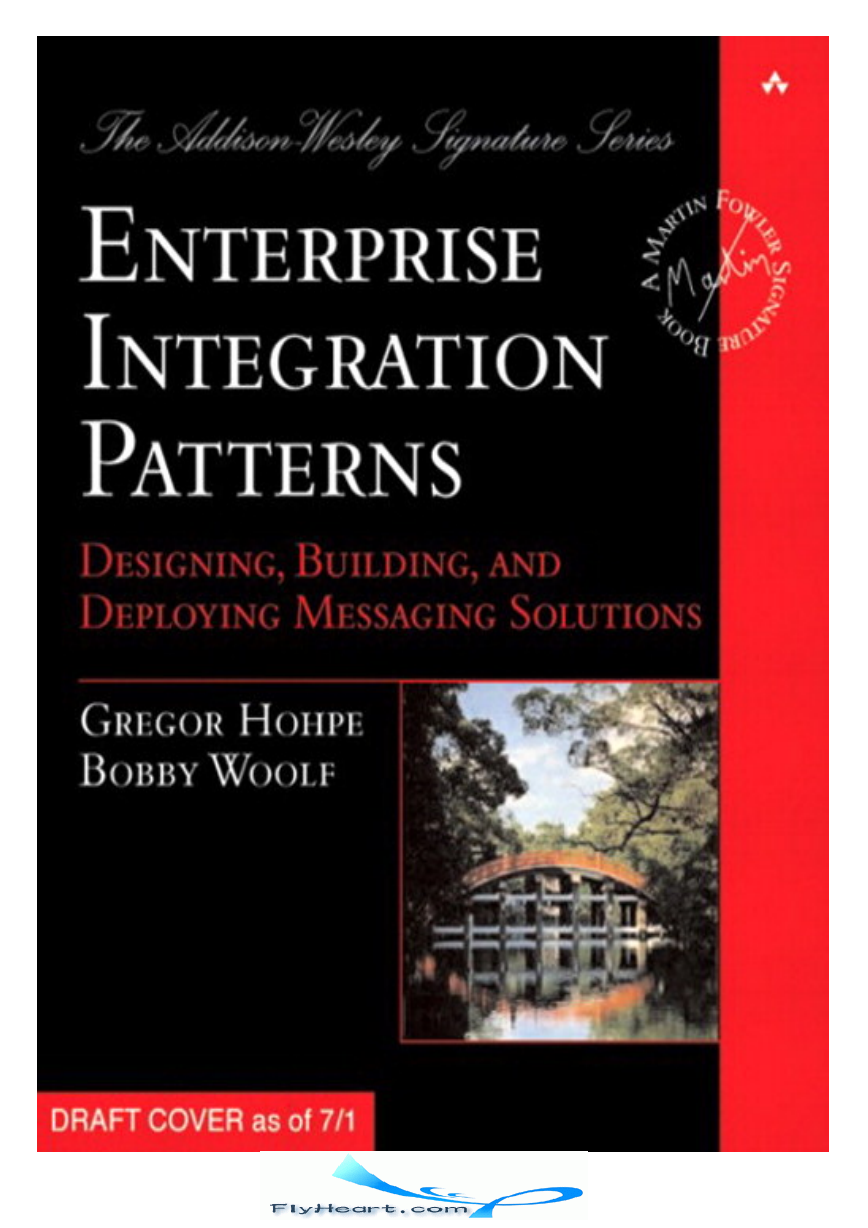
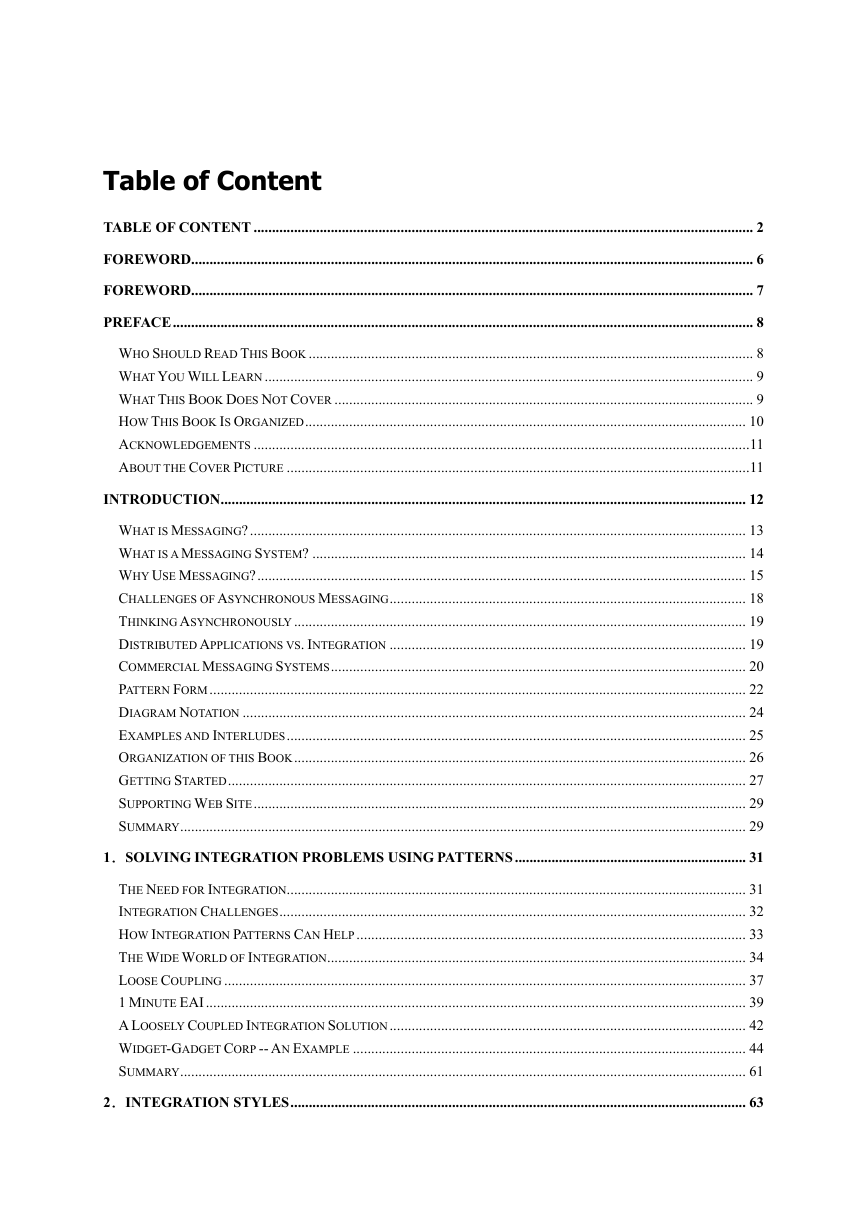
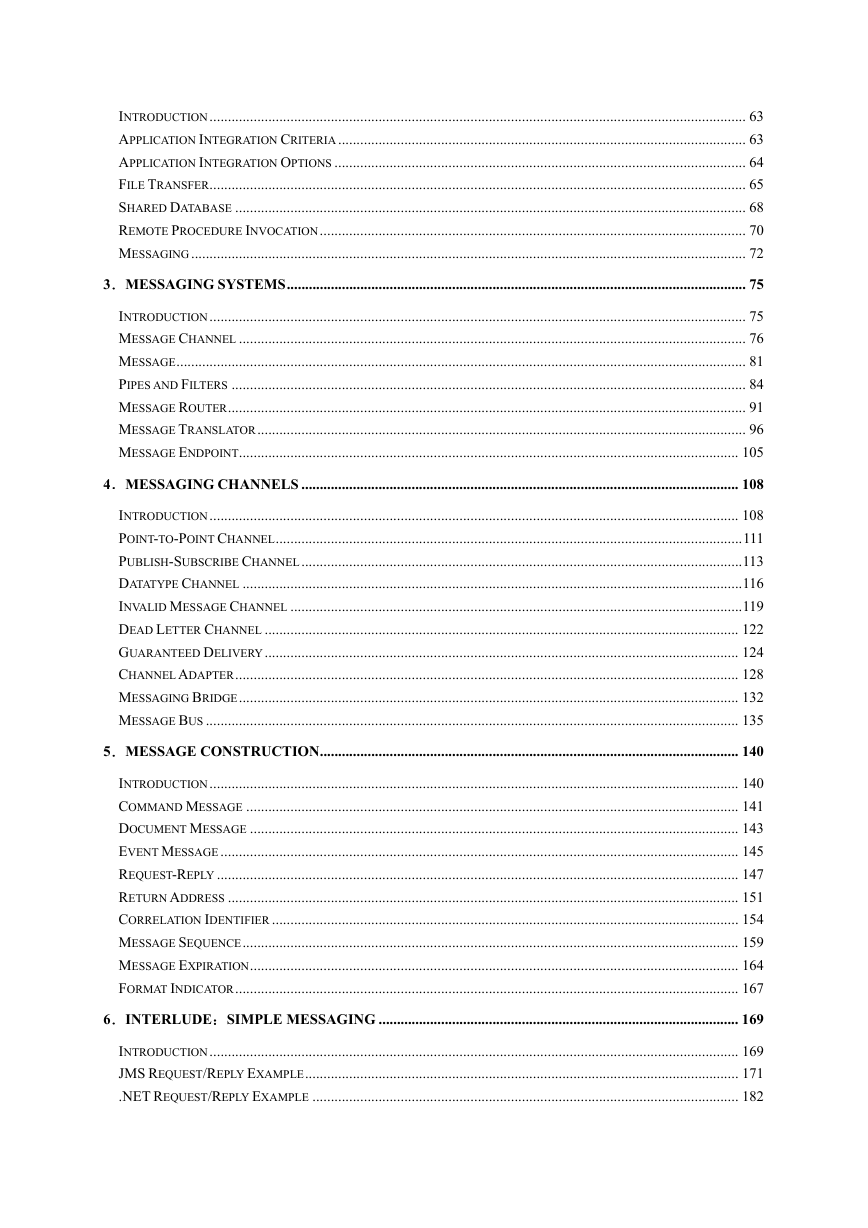


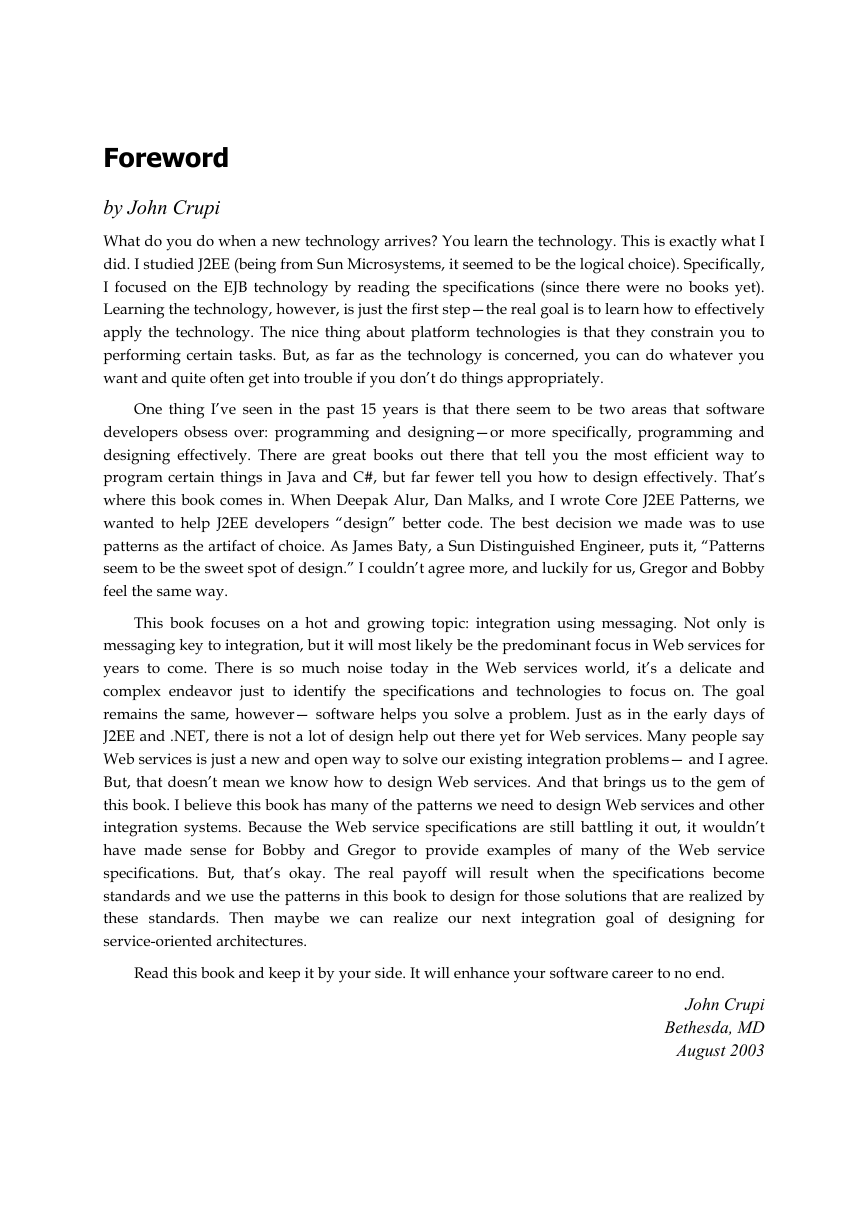
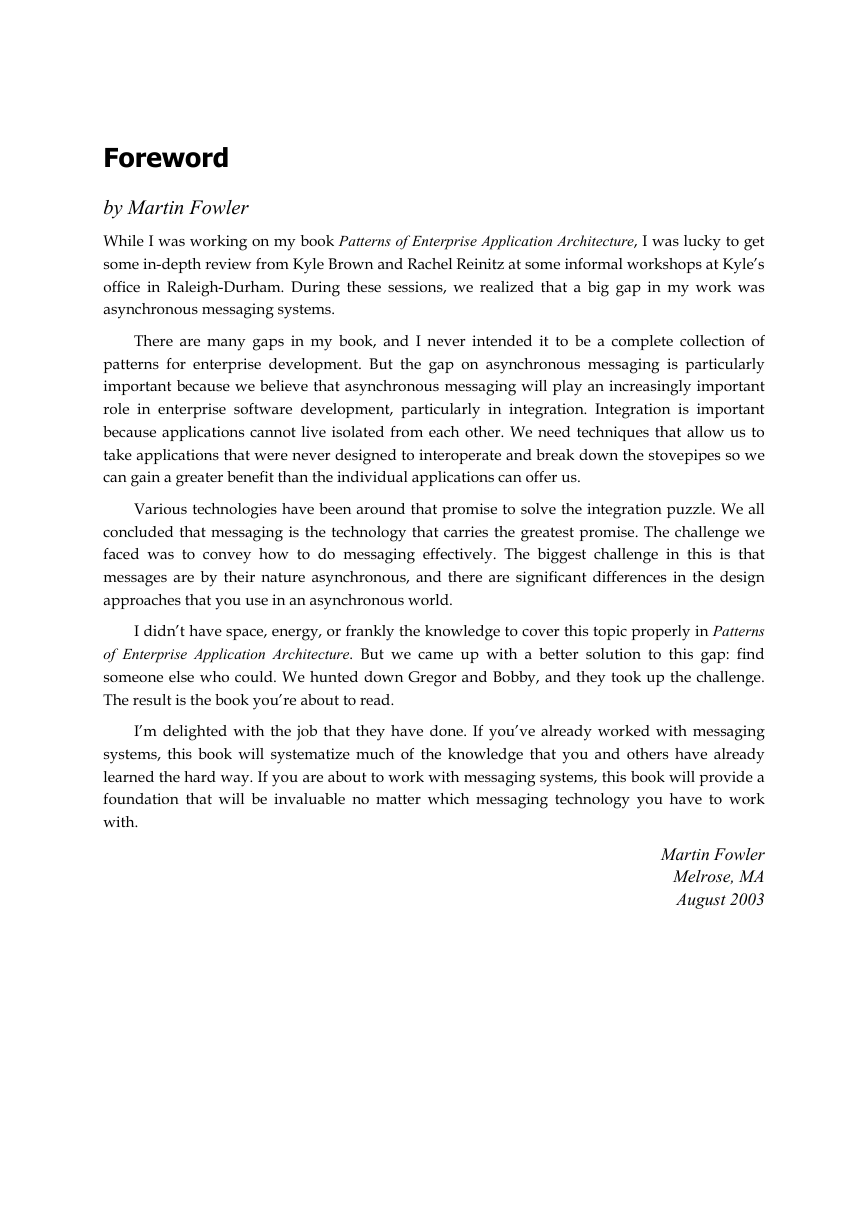
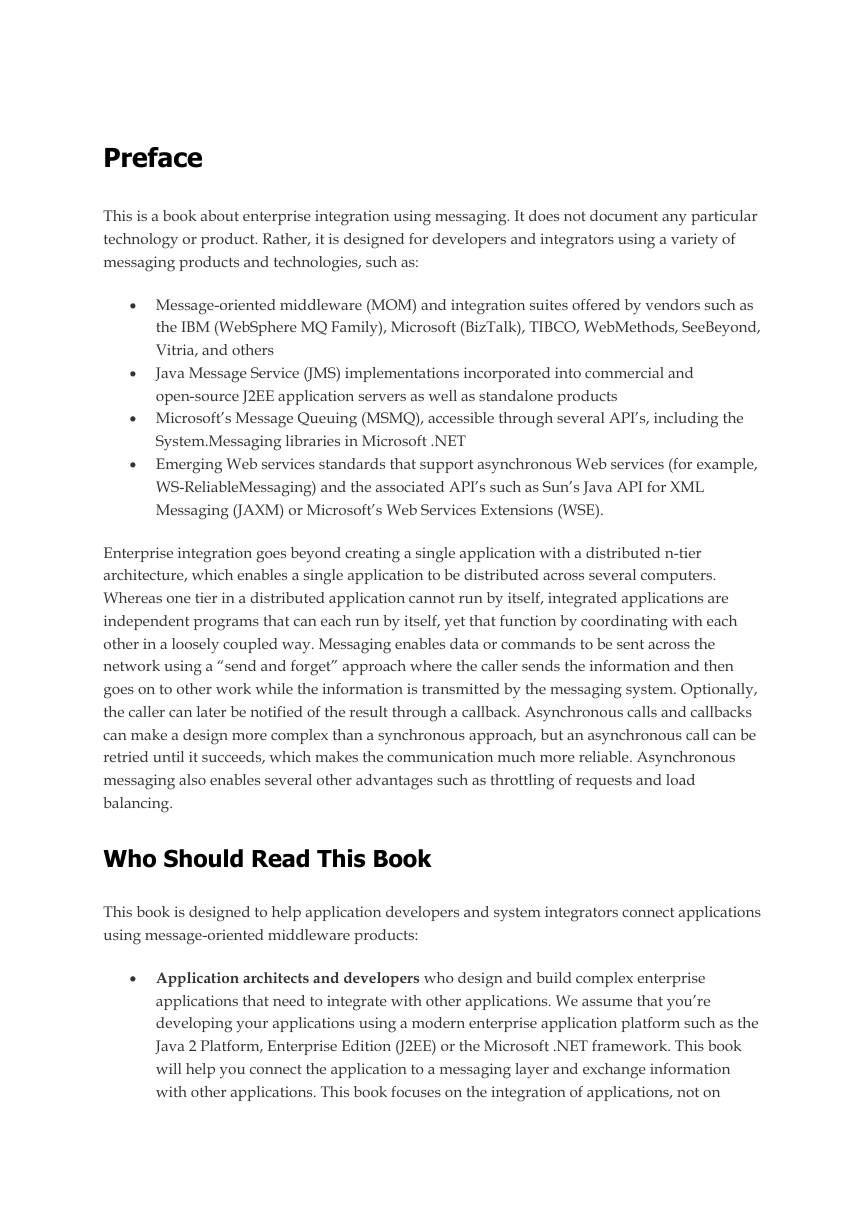








 2023年江西萍乡中考道德与法治真题及答案.doc
2023年江西萍乡中考道德与法治真题及答案.doc 2012年重庆南川中考生物真题及答案.doc
2012年重庆南川中考生物真题及答案.doc 2013年江西师范大学地理学综合及文艺理论基础考研真题.doc
2013年江西师范大学地理学综合及文艺理论基础考研真题.doc 2020年四川甘孜小升初语文真题及答案I卷.doc
2020年四川甘孜小升初语文真题及答案I卷.doc 2020年注册岩土工程师专业基础考试真题及答案.doc
2020年注册岩土工程师专业基础考试真题及答案.doc 2023-2024学年福建省厦门市九年级上学期数学月考试题及答案.doc
2023-2024学年福建省厦门市九年级上学期数学月考试题及答案.doc 2021-2022学年辽宁省沈阳市大东区九年级上学期语文期末试题及答案.doc
2021-2022学年辽宁省沈阳市大东区九年级上学期语文期末试题及答案.doc 2022-2023学年北京东城区初三第一学期物理期末试卷及答案.doc
2022-2023学年北京东城区初三第一学期物理期末试卷及答案.doc 2018上半年江西教师资格初中地理学科知识与教学能力真题及答案.doc
2018上半年江西教师资格初中地理学科知识与教学能力真题及答案.doc 2012年河北国家公务员申论考试真题及答案-省级.doc
2012年河北国家公务员申论考试真题及答案-省级.doc 2020-2021学年江苏省扬州市江都区邵樊片九年级上学期数学第一次质量检测试题及答案.doc
2020-2021学年江苏省扬州市江都区邵樊片九年级上学期数学第一次质量检测试题及答案.doc 2022下半年黑龙江教师资格证中学综合素质真题及答案.doc
2022下半年黑龙江教师资格证中学综合素质真题及答案.doc